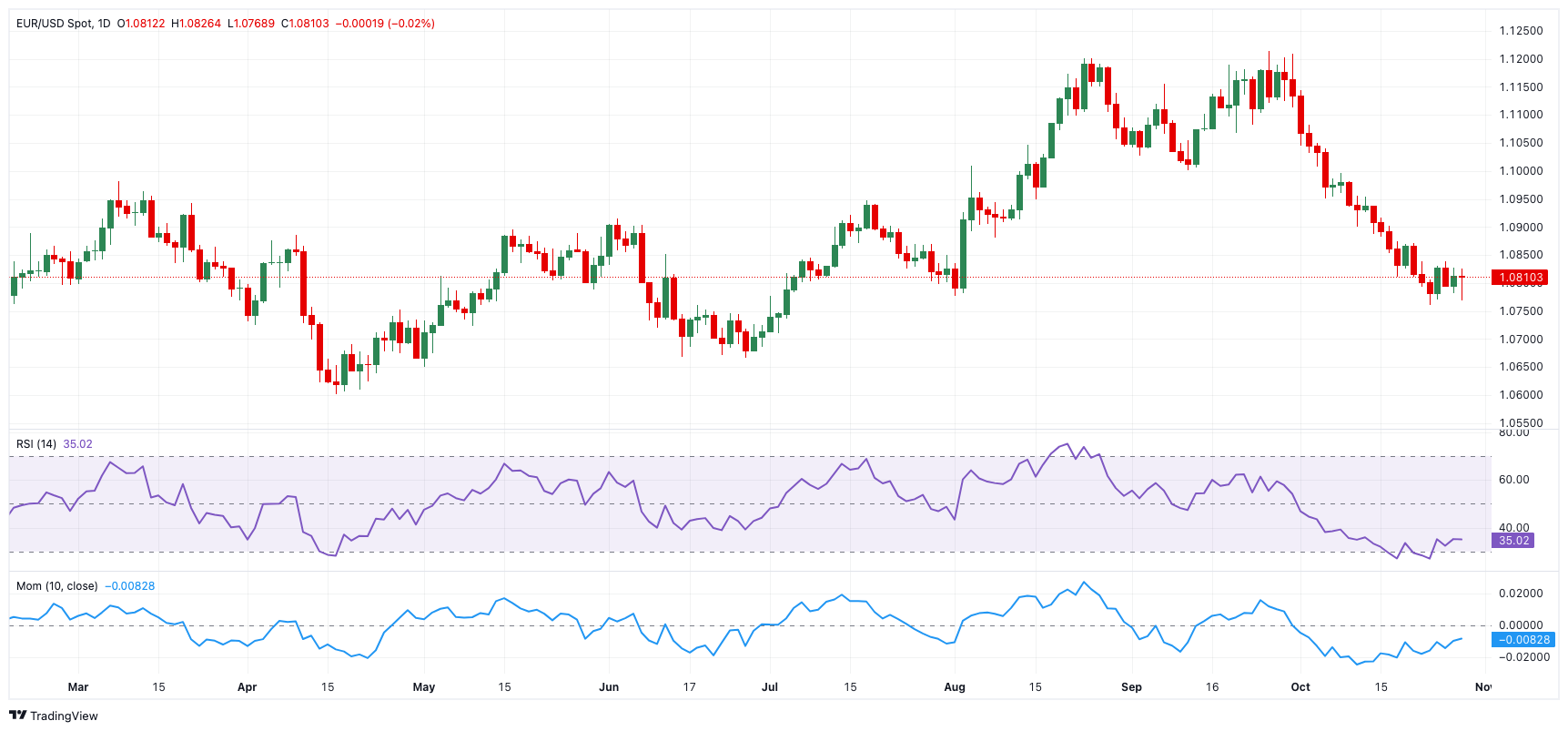- EUR/USD alternated gains with losses around the 1.0800 region.
- The US Dollar clung to daily gains following fresh tops.
- US Q3 GDP data, the ADP report, and German CPI come to the fore.
On Tuesday, EUR/USD struggled to extend Monday’s decent rebound, navigating a volatile range around the 1.0800 region after bottoming out near 1.0770 early in the day.
The pair, however, remained below the key 200-day Simple Moving Average (SMA) at 1.0868, suggesting the potential for further downside in the near term.
The US Dollar's (USD) rally showed signs of slowing its momentum despite the Dollar Index (DXY) clinching new highs past 104.60, while US yields also failed to sustain the initial bullish attempt vs. an acceptable bounce in German 10-year bund yields.
Looking ahead, expectations are building for a 25-basis-point rate cut by the Fed next month. However, some officials, including FOMC Governor Michelle Bowman and Atlanta Fed President Raphael Bostic, have expressed doubts. Bostic even suggested that the Fed might postpone a rate cut in November.
Currently, the CME Group’s FedWatch Tool almost fully prices in a quarter-point cut at the November 7 meeting.
Across the Atlantic, the European Central Bank (ECB) delivered a 25-basis-point rate cut on October 17, reducing the Deposit Facility Rate to 3.25%, in line with expectations. ECB officials have adopted a cautious stance on further rate changes, emphasizing the importance of incoming economic data. ECB President Christine Lagarde highlighted the need for prudence in future policy decisions amid the evolving economic environment.
Within the ECB, there are varying opinions on future rate cuts. Robert Holzmann supports a potential quarter-point reduction in December, while Bostjan Vasle advocates for "measured" cuts, cautioning against premature easing. Joachim Nagel warned against concluding the fight against inflation too early, and Martins Kazaks pointed out that although eurozone inflation, as measured by the Harmonised Index of Consumer Prices (HICP), declined to 1.7% year-on-year in September—below the ECB's target—stagnant GDP growth and continued weakness in German and eurozone business activity, particularly in manufacturing, suggest that gradual rate cuts remain necessary amid high uncertainty.
As both the Fed and ECB consider their next steps, the trajectory of EUR/USD is likely to depend on broader economic trends. With the US economy currently outperforming the eurozone, the USD may maintain its strength in the near to medium term. Additional support for the USD is expected in the event of a Trump victory in the upcoming election.
Furthermore, the latest CFTC Positioning Report for the week ending October 22 indicated that speculators shifted to a net short position on the euro for the first time since late April, while overall open interest continued to decline. During this period, EUR/USD remained under pressure, breaking below the 1.0900 support level and continuing a downward trend that began at the start of the month.
Looking ahead, the release of the advanced US Q3 GDP Growth Rate, the ADP report, and Germany's flash inflation figures are expected to dictate the sentiment in the very near term.
EUR/USD daily chart
EUR/USD short-term technical outlook
Further losses could drive EUR/USD to its October low of 1.0760 (October 23), clearing the way for a test of the round level at 1.0700 before the June low of 1.0666 (June 26).
On the upside, the 200-day SMA at 1.0868 is ahead, followed by the preliminary 100-day and 55-day SMAs at 1.0933 and 1.1023, respectively. The 2024 peak of 1.1214 (September 25) comes next, followed by the 2023 high of 1.1275 (July 18).
Meanwhile, the pair’s outlook should remain unfavourable as long as EUR/USD trades below the key 200-day SMA.
The four-hour chart shows the continuation of a range bound mood. Nonetheless, the initial support is at 1.0760, followed by 1.0666. On the upside, the first barrier is at 1.0839, followed by 1.0954 and 1.0996. The relative strength index (RSI) rose to nearly 50.
Information on these pages contains forward-looking statements that involve risks and uncertainties. Markets and instruments profiled on this page are for informational purposes only and should not in any way come across as a recommendation to buy or sell in these assets. You should do your own thorough research before making any investment decisions. FXStreet does not in any way guarantee that this information is free from mistakes, errors, or material misstatements. It also does not guarantee that this information is of a timely nature. Investing in Open Markets involves a great deal of risk, including the loss of all or a portion of your investment, as well as emotional distress. All risks, losses and costs associated with investing, including total loss of principal, are your responsibility. The views and opinions expressed in this article are those of the authors and do not necessarily reflect the official policy or position of FXStreet nor its advertisers. The author will not be held responsible for information that is found at the end of links posted on this page.
If not otherwise explicitly mentioned in the body of the article, at the time of writing, the author has no position in any stock mentioned in this article and no business relationship with any company mentioned. The author has not received compensation for writing this article, other than from FXStreet.
FXStreet and the author do not provide personalized recommendations. The author makes no representations as to the accuracy, completeness, or suitability of this information. FXStreet and the author will not be liable for any errors, omissions or any losses, injuries or damages arising from this information and its display or use. Errors and omissions excepted.
The author and FXStreet are not registered investment advisors and nothing in this article is intended to be investment advice.
Recommended Content
Editors’ Picks

EUR/USD holds losses below 1.1400 ahead of ECB policy decision
EUR/USD stays on the back foot below 1.1400 in the European session on Thursday. The pair loses ground on the back of a broad US Dollar rebound and as traders remain cautious ahead of the European Central Bank interest rate decision and Lagarde's press conference.

GBP/USD stays defensive near 1.3250 as US Dollar bounces
GBP/USD stays defensive near 1.3250 in Thursday's European trading, snapping its seven-day winning streak. A tepid US Dollar recovery amid risk appetite prompts the pair to pullback from six-month highs of 1.3292 set on Wednesday. Traders look to tariff headlibnes and US data for fresh impetus.

Gold price retreats from record high as profit-taking kicks in
Gold price retreats after touching a fresh all-time peak earlier this Thursday and erodes a part of the previous day's blowout rally though the downside remains cushioned. A slight improvement in the global risk sentiment, bolstered by hopes of US trade negotiations, turns out to be a key factor undermining the precious metal.

European Central Bank set to cut interest rates again amid easing inflation and tariff uncertainty
The European Central Bank will announce its April interest rate decision on Thursday at 12:15 GMT. Markets widely expect the central bank to lower key rates for the sixth consecutive time. This time the ECB is set to deliver another 25 basis points (bps) cut after the April policy meeting.

Future-proofing portfolios: A playbook for tariff and recession risks
It does seem like we will be talking tariffs for a while. And if tariffs stay — in some shape or form — even after negotiations, we’ll likely be talking about recession too. Higher input costs, persistent inflation, and tighter monetary policy are already weighing on global growth.

The Best brokers to trade EUR/USD
SPONSORED Discover the top brokers for trading EUR/USD in 2025. Our list features brokers with competitive spreads, fast execution, and powerful platforms. Whether you're a beginner or an expert, find the right partner to navigate the dynamic Forex market.
